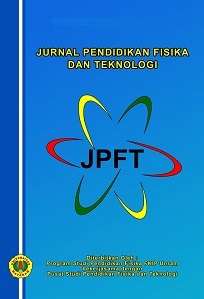Inovasi Bahan Ajar Dinamika Gerak dengan Modul Pembelajaran Berbasis Discovery Learning
DOI:
10.29303/jpft.v6i2.2064Published:
2020-12-01Issue:
Vol. 6 No. 2 (2020): Juli-DesemberKeywords:
discovery learning, learning physics, motion materialArticles
Downloads
How to Cite
Downloads
Metrics
Abstract
Physics learning with discovery learning approach requires students to be active in learning. In th schools in tangerang area, there is no discovery learning module available. the purpose of this research is to develop a physics learning module based on discovery learning on Motion materials. This research method is research & development with ADDIE model (analyze, design, development, implementetion, evaluation), using research instruments in the form of validation sheets. the data analysis technique used is descriptive analysis. The results of the study showed that discovery learning-based physics learning modules are worth testing and implementing to students. This module has characteristics according to discovery learning syntax and user friendly so that students can learn independently.
References
Astuti, I. A. D., Putra, I. Y., & Bhakti, Y. B. (2018). Developing Practicum Module of Particle Dynamics Based on Scientific Methods to Improve Students' Science Process Skills. Scientiae Educatia: Jurnal Pendidikan Sains, 7(2), 183-196.
Balñm, A. G. (2009). The Effects of Discovery Learning on Students' Success and Inquiry Learning Skills. Eurasian Journal of Educational Research (EJER), (35), 1-20.
Brigenta, D., Handhika, J., & Sasono, M. (2017). Pengembangan modul berbasis discovery learning untuk meningkatkan pemahaman konsep. Seminar Nasional Pendidikan Fisika III 2017, Madiun, 15 Juli 2017, 167ââ¬â173. http://e-journal.unipma.ac.id/index.php/snpf
Haeruman, L. D., Rahayu, W., & Ambarwati, L. (2017). Pengaruh Model Discovery Learning Terhadap Peningkatan Kemampuan Berpikir Kritis Matematis Dan Self-Confidence Ditinjau Dari Kemampuan Awal Matematis Siswa Sma Di Bogor Timur. Jurnal Penelitian Dan Pembelajaran Matematika, 10(2), 157ââ¬â168. https://doi.org/10.30870/jppm.v10i2.2040
Haryanti, F., & Saputro, B. A. (2016). Pengembangan Modul Matematika Berbasis Discovery Learning Berbantuan FlipBook Maker Untuk Meningkatkan Kemampuan Pemahaman Konsep Siswa Pada Materi Segitiga. Kalamatika: Jurnal Pendidikan Matematika, 1(2), 147-161.
Hosnan. (2014). Implementasi Saintifik dan Kontekstual dalam Pembelajaran Abad 21.Bogor: Ghalia Indonesia
Jamilah, Jampel, I. N., & Parmiti, D. P. (2017). Pengembangan Modul Pembelajaran Berbasis Discovery Mata Pelajaran IPA Siswa SD No 1 Baktiseraga Kelas IV. E-Journal Edutech Universitas Pendidikan Ganesha, Vol: 8 No.(1), 189ââ¬â198.
Kurniati, I. W., Pujiastuti, E., & Kurniasih, A. W. (2017). Model Pembelajaran Discovery Learning Berbantuan Smart Sticker untuk Meningkatkan Disposisi Matematik dan Kemampuan Berpikir Kritis. Kreano, Jurnal Matematika Kreatif-Inovatif, 8(2), 109ââ¬â118. https://doi.org/10.15294/kreano.v8i2.5060
Mukarramah, M., Hartini, S., & Salam, A. (2017). Pengembangan Modul Fisika pada Pokok Bahasan Listrik Dinamis dengan Menggunakan Model Discovery Learning di SMAN 5 Banjarmasin. Jurnal Fisika Flux: Jurnal Ilmiah Fisika FMIPA Univeb xjorsitas Lambung Mangkurat, 13(2), 121-125.
Palupi, A. E. (2013). Pengembangan modul pembelajaran CNC II untuk meningkatkan efektivitas belajar mahasiswa program studi D3 teknik mesin fakultas teknik Universitas Negeri Surabaya. Jurnal Pendidikan Teknik Mesin, 1(03), 77-85.
Putri, T. P., Fadiawati, N., & Rudibyani, R. B. (2014). Model discovery learning dalam meningkatkan keterampilan berpikir fleksibel pada materi asam-basa. Jurnal Pendidikan dan Pembelajaran Kimia, 3(2)
Rahmawati, E., Astuti, I. A. D., & Nurhayati, N. (2020). Development of Physics Learning Module Based on Guided Inquiry with Light Wave Material in Class XI of Senior High School. Bulletin of Educational Science and Technology, 1(1), 1-10.
Uside, O. N., Barchock, K. H., & Abura, O. G. (2013). Effect of discovery method on secondary school studentââ¬â¢s achievement in physics in Kenya. Chuka University Journal, 2(30, 357-359.
Widyastuti, I. N., Wiryokusumo, I., & Sugito. (2019). Pengembangan Modul Pembelajaran Dengan Model Dick and Carey Dan Menggunakan Concept Mapping Pada Mata Pelajaran Ekonomi Kelas Xi Ips Di Sma Negeri 1. Sampang Semester Ganjil Tahun Ajaran 2018/2019 Jurnal Education And Development, 7(2), 175ââ¬â180.
Yerimadesi, Y., Putra, A., & Ririanti, R. (2017). Efektivitas Penggunaan Modul Larutan Penyangga Berbasis Discovery Learning terhadap Hasil Belajar Siswa Kelas XI MIA SMAN 7 Padang. Jurnal Eksakta Pendidikan (JEP), 1(1), 17-23.
Author Biographies
Siti Halimatul Fatihah, Universitas Indraprasta PGRI
Neng Nenden Mulyaningsih, Universitas Indraprasta PGRI
Irnin Agustina Dwi Astuti, Universitas Indraprasta PGRI
License
Authors who publish with Jurnal Pendidikan Fisika dan Teknologi (JPFT) agree to the following terms:
- Authors retain copyright and grant the journal right of first publication with the work simultaneously licensed under a Creative Commons Attribution License 4.0 International License (CC-BY-SA License). This license allows authors to use all articles, data sets, graphics, and appendices in data mining applications, search engines, web sites, blogs, and other platforms by providing an appropriate reference. The journal allows the author(s) to hold the copyright without restrictions and will retain publishing rights without restrictions.
- Authors are able to enter into separate, additional contractual arrangements for the non-exclusive distribution of the journal's published version of the work (e.g., post it to an institutional repository or publish it in a book), with an acknowledgement of its initial publication in Jurnal Pendidikan Fisika dan Teknologi (JPFT).
- Authors are permitted and encouraged to post their work online (e.g., in institutional repositories or on their website) prior to and during the submission process, as it can lead to productive exchanges, as well as earlier and greater citation of published work (See The Effect of Open Access).











